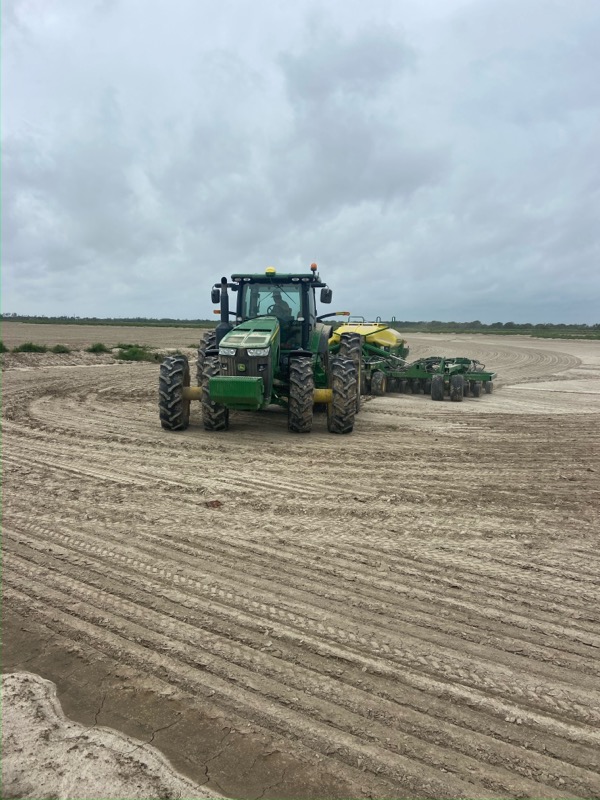 #Plant22 has begun despite persistent cloudy skies
#Plant22 has begun despite persistent cloudy skies
Apr 08, 2022
MOUNTAIN HOME, TX -- Rice planting is well underway in southwest Louisiana and Texas. However, the crop is progressing slowly due to a variety of factors.
“We are approximately 75 percent planted,” said Wayne Hensgen with Simplot in Crowley. “However, there will be some prevented planting acres in coastal parishes because of lack of water and high salinity.”
Southwest Louisiana has had an abnormally low level of rainfall since late October which has led to a lack of surface water and high salinity water moving north from the Gulf of Mexico that impacts those who use surface water for rice irrigation in those areas.
“Saltwater issues down south will affect some rice acres,” said Justin Nix with Helena in Morse. “Although we got off to an early start in planting, cool weather has slowed the young rice.” Nix also speculated that a combination of Provisia and MaxAce acres could approach 40+ percent of the southwest Louisiana crop. Both of these technologies use varieties resistant to quizalofop herbicide in a weedy rice control program.
Richard Fontenot in Evangeline Parish agreed that the crop is off to a slow start because of cool temperatures. He had some water-seeded rice that was over three weeks from planting that is not much beyond the one leaf stage.
“We had an early start with dry conditions in February and March and numbers indicate that we are 75-80 percent planted,” said David Trahan with Crowley Grain. “Rice is progressing slowly because of cool conditions, and we have some suspect stands primarily because of a combination of cool weather and low seeding rates.” Trahan added that his growers were planting a lot of acres of Provisia rice and that fertilizer prices are the highest that he has seen in his career.
LG Raun who farms near El Campo, Texas, finished planting his rice crop the first week of March, ahead of most of his neighbors. The majority of the crop in his region, except the organic rice crop, is planted. Texas is projecting approximately 20,000 acres of organic rice this year and most of that is normally planted later.
Cliff Mock farms and consults southwest of Houston, and reported that his personal crop and the acres on which he consults is 90+ percent planted. Those numbers probably represent the overall rice area west of Houston. The rice crop east of Houston is normally planted a little later and this year is no exception. Both Raun and Mock indicated that the rice has grown slowly this spring similar to what is being observed in southwest Louisiana.
Gary Bradshaw, an independent consultant, says his growers started planting on March 4 and finished by April 2. “We’ve been dealing with the typical issues on the prairies west of Houston, namely relentless winds. Those conditions make herbicide applications difficult and cause sand to blow and damage seedling rice.”
“My rice acres are 50 percent planted and 20 percent emerged,” said Dorsey Jones with Helena in Raywood, Texas. “Soils are quickly drying out and growers are flushing fields to facilitate emergence on the later-planted rice and to activate herbicides.”
There has not been a great deal of rice planted yet in north Louisiana, Arkansas, Missouri, and Mississippi, and current wet conditions are slowing progress in those regions.
Marley Oldham, with Kennedy Rice Mill in Mer Rouge, Louisiana, said that his farmers were less than 5 percent planted with wet conditions hampering progress especially on the heavier soils.
Arkansas rice specialist Jarrod Hardke reported that very little rice had been planted overall. “The entire state received more than an inch of rainfall on Monday and Tuesday with more on the way to start next week. One grower told me he may have to plant this crop ‘one day at a time.’ We’re likely way behind the five-year average and that’s saying something considering the slow pace of the past few years. We’ll be lucky to be 5 percent planted in the upcoming Monday report and we’re usually over 20 percent at that time.”
Garrett Williams with Producers Rice Mill in Stuttgart, Arkansas, indicated that some rice was planted in the last few days of March before last week’s rain.
“I have only heard of 100 acres planted as well as one of our research trials,” said Missouri rice specialist Justin Chlapecka. “We received 1.5 inches of rain Tuesday night and the forecast is for additional rain in the next few days. This will likely put us behind the eight-ball on planting so we are hoping for drier conditions.”
“We have had a few acres planted in the last couple weeks,” said Hunter Bowman, Mississippi State rice specialist. “For the most part, Mississippi growers are holding off for a clear weather pattern. I would say that overall, we have 10-15 percent of the state’s rice acres planted.”